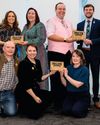試す 金 - 無料
Silver Darlings
The Scots Magazine
|July 2025
Seasonal migrations turned Scotland's herring girls into spirited workers and storytellers

If you look closely at the coat of arms of Stornoway, you'll see how its people and the seas shaped the soul of the town. The colours recognise the three families who have had the most influence on the island: the MacLeods, the MacKenzies and the Mathesons. Along with the castle, the symbols in the shield represent a ship and the most important fish to the island - the herring.
My father, brothers, uncles, grandfathers, and the generations before them, worked as fishermen. But this story talks of the women in my family and how the seas changed their lives.
My granny, Anna Sheonaidh, was born in Marvig in 1900. Back then, opportunities for island women were few, but the sea offered work, if not rest.
 Each season, along with nearly 2,000 other local women, she packed her belongings into a wooden chest - her ciste - and set out from Stornoway, bound for the herring ports of Lerwick, Wick, Peterhead, and even as far as Yarmouth and Lowestoft.
Each season, along with nearly 2,000 other local women, she packed her belongings into a wooden chest - her ciste - and set out from Stornoway, bound for the herring ports of Lerwick, Wick, Peterhead, and even as far as Yarmouth and Lowestoft.The journey began on the mail steamer to Kyle, followed by long train rides across the country. Those carriages and decks echoed with Gaelic song and laughter as the women caught up with news from other villages.
They travelled in crews of three - two gutters and a packer - and worked at blistering speed. With a swift twist of the wrist, they gutted 30 to 50 herring a minute, fingers wrapped in bandages to guard against the sharp blade of the cutag. A cooper would bang at their doors at 5am, shouting “Get up and bandage your fingers”, and by dawn the girls would be elbow deep in salt and scales.
When Queen Elizabeth II visited Stornoway for the first time in 1956, she was presented with a golden cutag inscribed with the town's motto: God's Providence Is Our Inheritance.
このストーリーは、The Scots Magazine の July 2025 版からのものです。
Magzter GOLD を購読すると、厳選された何千ものプレミアム記事や、10,000 以上の雑誌や新聞にアクセスできます。
すでに購読者ですか? サインイン
The Scots Magazine からのその他のストーリー

The Scots Magazine
Going Undercover
Author Maggie Ritchie shares how a female artist who once cracked codes at Bletchley Park has inspired her new novel
5 mins
November 2025

The Scots Magazine
Wild Flavours
Discover Scotland's natural ingredients with foraging expert Lucy Cooke
3 mins
November 2025
The Scots Magazine
Harriet Slater
The Outlander actress shares her experience of the hit series
2 mins
November 2025

The Scots Magazine
A Guid Blether
The 2025 Scots Language Awards in Dundee celebrated writers, performers and educators, showing that Scots is alive and thriving
3 mins
November 2025

The Scots Magazine
my Scotland
Crime writer Liam McIlvanney shares the places and landscapes that helped shape his imagination
2 mins
November 2025

The Scots Magazine
A Family Blend
Like a good whisky, the West Highland Way is full of character and better when shared with family
3 mins
November 2025

The Scots Magazine
Braeriach
With its dramatic ridges and awe-inspiring views, Scotland's third-highest peak beckons
3 mins
November 2025

The Scots Magazine
FROM THE VAULT
Unique tales from our archives. This month: Scotland's centuries-old love of coffee
1 mins
November 2025

The Scots Magazine
When In Rome
Beth McHugh visits Trimontium Museum to learn the story of Scotland's greatest Roman fort
3 mins
November 2025

The Scots Magazine
Call Of The Wild
Rachel McConachie spends a magical night in Ruberslaw Wild Woods and recommends other quirky stays in this area
4 mins
November 2025
Listen
Translate
Change font size
